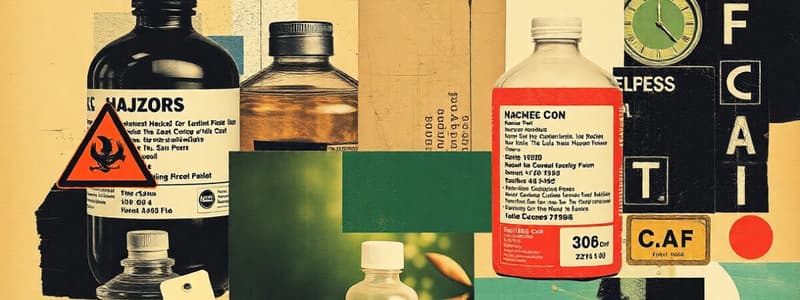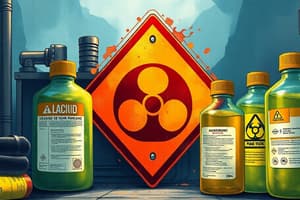Podcast
Questions and Answers
What is the primary hazard associated with OXI252 as indicated on the label?
What is the primary hazard associated with OXI252 as indicated on the label?
- Causes mild irritation to skin
- Causes respiratory issues
- May cause fire or explosion; strong oxidizer (correct)
- May cause skin allergies
Which of the following precautionary measures is NOT mentioned for handling OXI252?
Which of the following precautionary measures is NOT mentioned for handling OXI252?
- Keep away from heat
- Wear protective neoprene gloves
- Wear fire/flame resistant clothing
- Use a chemical fume hood (correct)
What type of personal protective equipment is recommended when handling OXI252?
What type of personal protective equipment is recommended when handling OXI252?
- Dust mask and long sleeves
- Safety goggles and gloves
- Neoprene gloves, safety goggles, and face shield (correct)
- Face shield and ear protection
Which of the following statements accurately reflects a potential effect of OXI252 exposure?
Which of the following statements accurately reflects a potential effect of OXI252 exposure?
In the event of an exposure to OXI252, what step is advised regarding seeking medical help?
In the event of an exposure to OXI252, what step is advised regarding seeking medical help?
What is the primary purpose of labels for hazardous chemicals?
What is the primary purpose of labels for hazardous chemicals?
Which of the following is NOT a required element on hazardous chemical labels as per the HCS?
Which of the following is NOT a required element on hazardous chemical labels as per the HCS?
How often was the Hazard Communication Standard (HCS) revised prior to 2012?
How often was the Hazard Communication Standard (HCS) revised prior to 2012?
Which signal words are specifically defined to indicate the level of hazard on a chemical label?
Which signal words are specifically defined to indicate the level of hazard on a chemical label?
What is the role of Safety Data Sheets (SDSs) in relation to labels?
What is the role of Safety Data Sheets (SDSs) in relation to labels?
What must be included in the labeling of hazardous chemicals according to the revised HCS?
What must be included in the labeling of hazardous chemicals according to the revised HCS?
What limitation do labels for hazardous chemicals possess?
What limitation do labels for hazardous chemicals possess?
What is the purpose of the precautionary statements on chemical labels?
What is the purpose of the precautionary statements on chemical labels?
Which of the following statements is NOT included among the precautionary statements for self-reactive hazard categories?
Which of the following statements is NOT included among the precautionary statements for self-reactive hazard categories?
What characteristic defines a valid pictogram for hazardous chemicals?
What characteristic defines a valid pictogram for hazardous chemicals?
In chemical labeling, what should a manufacturer prioritize if multiple hazard statements are similar?
In chemical labeling, what should a manufacturer prioritize if multiple hazard statements are similar?
Which item is classified as supplementary information on chemical labels?
Which item is classified as supplementary information on chemical labels?
What does the HMIS pictogram typically depict for workers handling chemicals?
What does the HMIS pictogram typically depict for workers handling chemicals?
What is a defining feature of precautionary statements related to chemicals in self-reactive hazard categories?
What is a defining feature of precautionary statements related to chemicals in self-reactive hazard categories?
What should a user do if a chemical label contains contradictory information?
What should a user do if a chemical label contains contradictory information?
What type of information might NOT be considered supplementary on chemical labels?
What type of information might NOT be considered supplementary on chemical labels?
Which pictogram is not enforced by OSHA?
Which pictogram is not enforced by OSHA?
What must labels containing OSHA pictograms be?
What must labels containing OSHA pictograms be?
How many pictograms are enforced by OSHA?
How many pictograms are enforced by OSHA?
In what scenario might both DOT and HCS pictograms be present on the same label?
In what scenario might both DOT and HCS pictograms be present on the same label?
Which federal regulation outlines DOT requirements for labeling?
Which federal regulation outlines DOT requirements for labeling?
Which of the following is a characteristic of the DOT diamond label?
Which of the following is a characteristic of the DOT diamond label?
What does OSHA's revision intend to address regarding pictograms?
What does OSHA's revision intend to address regarding pictograms?
Which of the following may not require a DOT diamond label?
Which of the following may not require a DOT diamond label?
What is a common feature of most symbols used for hazardous chemicals?
What is a common feature of most symbols used for hazardous chemicals?
Which statement is accurate concerning additional language on labels?
Which statement is accurate concerning additional language on labels?
What is required for an employer's workplace labeling system to be compliant with HazCom 1994?
What is required for an employer's workplace labeling system to be compliant with HazCom 1994?
What must an employer do if they use NFPA or HMIS labeling systems?
What must an employer do if they use NFPA or HMIS labeling systems?
Which of the following types of information is NOT necessary on a workplace label?
Which of the following types of information is NOT necessary on a workplace label?
What is a key feature of labeling for portable containers intended for immediate use?
What is a key feature of labeling for portable containers intended for immediate use?
When can an employer create their own workplace labels?
When can an employer create their own workplace labels?
Which statement best describes how an employer can utilize signs or placards in their labeling system?
Which statement best describes how an employer can utilize signs or placards in their labeling system?
What process does a manufacturer use to determine the required pictograms and hazard statements?
What process does a manufacturer use to determine the required pictograms and hazard statements?
Which piece of information is essential to include on any workplace label?
Which piece of information is essential to include on any workplace label?
What is the purpose of requiring immediate access to information about the chemicals used in the workplace?
What is the purpose of requiring immediate access to information about the chemicals used in the workplace?
Which of the following statements is true regarding the transfer of hazardous chemicals?
Which of the following statements is true regarding the transfer of hazardous chemicals?
Flashcards
Chemical Label
Chemical Label
A set of written, printed, or graphic instructions attached to a hazardous chemical container, providing information to handle it safely.
Signal Word
Signal Word
The label's primary signal to warn the user of immediate and serious hazards.
Hazard Statement
Hazard Statement
A brief statement describing the specific hazard(s) posed by a chemical.
Precautionary Statement
Precautionary Statement
Signup and view all the flashcards
Pictogram
Pictogram
Signup and view all the flashcards
Labeling Requirement
Labeling Requirement
Signup and view all the flashcards
Safety Data Sheet (SDS)
Safety Data Sheet (SDS)
Signup and view all the flashcards
Storage and Disposal
Storage and Disposal
Signup and view all the flashcards
Precautionary Statement Precedence
Precautionary Statement Precedence
Signup and view all the flashcards
Precautionary Statements for Response
Precautionary Statements for Response
Signup and view all the flashcards
Self-Reactive Hazard Categories
Self-Reactive Hazard Categories
Signup and view all the flashcards
Storage Instructions for Self-Reactive Chemicals
Storage Instructions for Self-Reactive Chemicals
Signup and view all the flashcards
Supplementary Information on Chemical Labels
Supplementary Information on Chemical Labels
Signup and view all the flashcards
PPE Pictograms
PPE Pictograms
Signup and view all the flashcards
Hazardous Materials Identification System (HMIS)
Hazardous Materials Identification System (HMIS)
Signup and view all the flashcards
Standard Pictogram Format
Standard Pictogram Format
Signup and view all the flashcards
GHS Pictograms
GHS Pictograms
Signup and view all the flashcards
GHS
GHS
Signup and view all the flashcards
OSHA
OSHA
Signup and view all the flashcards
Environmental Pictogram
Environmental Pictogram
Signup and view all the flashcards
DOT
DOT
Signup and view all the flashcards
DOT Diamond Label
DOT Diamond Label
Signup and view all the flashcards
OSHA Pictograms on Smaller Containers
OSHA Pictograms on Smaller Containers
Signup and view all the flashcards
Label Requirements
Label Requirements
Signup and view all the flashcards
DOT vs. OSHA Pictograms
DOT vs. OSHA Pictograms
Signup and view all the flashcards
Multi-Language Labels
Multi-Language Labels
Signup and view all the flashcards
Workplace Labels
Workplace Labels
Signup and view all the flashcards
Label Placement
Label Placement
Signup and view all the flashcards
Workplace Labeling Systems
Workplace Labeling Systems
Signup and view all the flashcards
Training for NFPA/HMIS Labeling
Training for NFPA/HMIS Labeling
Signup and view all the flashcards
Temporary Containers
Temporary Containers
Signup and view all the flashcards
Existing Labeling Systems
Existing Labeling Systems
Signup and view all the flashcards
Chemical Classification
Chemical Classification
Signup and view all the flashcards
Selecting Label Elements
Selecting Label Elements
Signup and view all the flashcards
Emergency Access to Information
Emergency Access to Information
Signup and view all the flashcards
Label Information Combination
Label Information Combination
Signup and view all the flashcards
Study Notes
Hazard Communication Standard: Labels and Pictograms
- OSHA adopted new hazardous chemical labeling requirements
- These requirements align with the Globally Harmonized System of Classification and Labelling of Chemicals (GHS)
- This enhances worker comprehension and consistency in classification and labeling chemicals
- The revised standard shifted from a performance-based to a more structured approach for chemical labeling
- It requires quick visual notations on labels to alert users about chemical hazards
- Labels provide instructions on handling chemicals and protection measures
- Safety Data Sheets (SDSs) are the more complete resource for information on hazardous chemicals, requiring a 16-section format
- All hazardous chemicals shipped after June 1, 2015, must adhere to the new labeling requirements
- Manufacturers, importers, and distributors can use the revised system before the June 1, 2015, effective date if they choose to.
- Existing compliance with HazCom 1994 remains valid until December 1, 2015,
- Labels must contain name, address and telephone number of manufacturer/importer
- Pictograms, signal words, hazard statements and precautionary statements
- Label requirements for hazard classification, signal words and hazard statements.
Label Requirements
- Labels are defined as written, printed, or graphic information affixed to chemical containers
- Labels contain:
- Name, address, and telephone number of the chemical manufacturer, importer, or responsible party
- Product identifier (chemical name, code number, or batch number)
- Signal word ("Danger" or "Warning," depending on severity of hazard)
- Hazard statements (describe the nature of hazards)
- Precautionary statements (steps for minimizing exposure) and pictograms
- Pictograms are graphic symbols used to represent different hazards
- Supplementary information permitted on labels (e.g., unknown acute toxicity percentage)
- Employers must provide appropriate labeling systems to meet OSHA standards
Supplementary Information on Labels
- Supplementary information is optional, used to provide additional helpful details
- Permits listing hazards not otherwise classified
- Must indicate percentage of unknown acute toxicity ingredients (≥1%)
- May include additional information such as directions of use, expiration dates, etc.
- The information cannot contradict or detract from the required information
Employer Responsibilities
- Employers are responsible for maintaining chemical labels, ensuring legibility and hazard information isn't obscured
Workplace Labels
- Employers can create their own workplace labels containing all required information or in addition to labels from manufacturers, importers, or distributors
- Labels may include instructional symbols or other safety information
Studying That Suits You
Use AI to generate personalized quizzes and flashcards to suit your learning preferences.
Related Documents
Description
Test your knowledge on the OSHA's Hazard Communication Standard and the Globally Harmonized System for labeling chemicals. This quiz focuses on the key changes in labeling requirements, including the importance of pictograms and Safety Data Sheets. Understand how these standards enhance safety and communication in handling hazardous materials.




